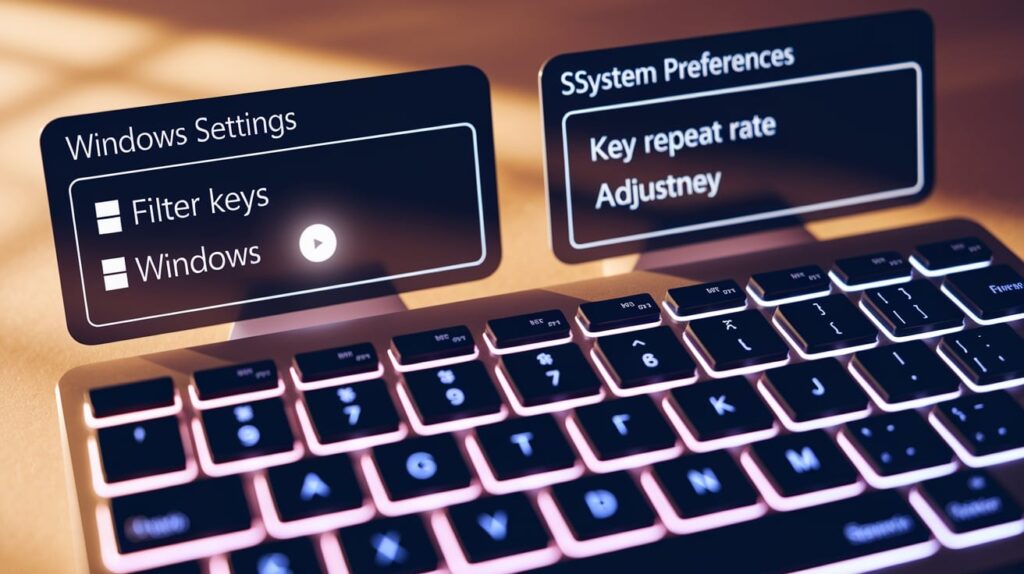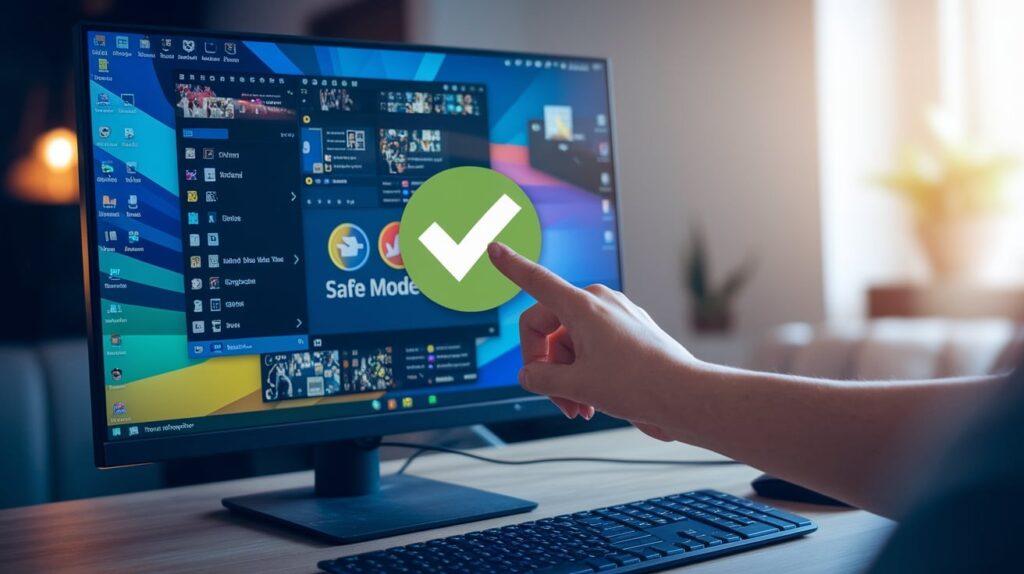Are you frustrated with delayed keystrokes ruining your typing flow or gaming sessions?
Nothing kills productivity quite like a keyboard that refuses to keep up with your fingers. You press a key, wait… and finally see the letter appear on screen seconds later.
This maddening delay affects everything from writing emails to competitive gaming.
The good news? Most keyboard response issues stem from fixable causes – whether it’s outdated drivers, system conflicts, or simple hardware connections.
In this guide, we’ll walk through seven proven methods on how to fix keyboard lag that work for both wired and wireless setups.
These solutions range from quick two-minute fixes to slightly more technical adjustments, but all are designed to get your keyboard responding instantly again.
Ready to restore that crisp, immediate response you expect from every keystroke?
What Is Keyboard Lag?
Keyboard lag refers to the noticeable delay between pressing a key and seeing the corresponding character or action appear on your screen.
This input delay can range from barely perceptible milliseconds to several seconds of frustrating wait time.
The root causes fall into two main categories. Hardware lag stems from physical issues like faulty cables, low wireless signal strength, or aging keyboard components that slow down signal transmission.
Software lag, on the other hand, originates from your computer’s operating system, drivers, or running applications that create bottlenecks in processing your keystrokes.
Understanding this distinction helps pinpoint the right solution.
Hardware problems typically require physical inspection or replacement, while software issues often respond to driver updates, system optimization, or configuration changes.
Common Symptoms of keyboard lag
- Delay between key press and on-screen response – You type a letter but it appears 1-3 seconds later, disrupting your natural typing rhythm
- Repeated or missed keystrokes – Single key presses register multiple times, or certain keys fail to register at all despite being pressed firmly
- Inconsistent response timing – Some keys respond immediately while others lag behind, creating an uneven typing experience
- Input queue backup – Multiple keystrokes appear all at once after a delay, suggesting your input is being buffered rather than processed in real-time
Types of Keyboard Lag
Wired vs. Wireless Keyboard Lag
|
Wired Keyboards |
Wireless Keyboards |
|
USB port issues – Faulty or damaged USB ports can interrupt signal transmission |
Battery levels – Low battery power reduces signal strength and response time |
|
Cable damage – Worn, bent, or internally broken cables cause intermittent connections |
Interference – Other wireless devices (mice, routers, phones) can disrupt the 2.4GHz signal |
|
USB hub overload – Too many devices on one hub can create bandwidth bottlenecks |
Distance from receiver – Being too far from the USB receiver weakens the connection |
|
Driver conflicts – Outdated or corrupted USB drivers affect communication |
Receiver placement – USB receivers blocked by metal objects or placed in poor locations |
|
Port power management – Windows may disable USB ports to save power |
Pairing issues – Lost connection between keyboard and receiver requires re-syncing |
Gaming vs. Typing Lag
|
Gaming Scenarios |
Regular Typing Scenarios |
|
Critical timing – Split-second reactions determine win/loss outcomes, making even 50ms delays noticeable |
Forgiving tolerance – Most typing tasks can accommodate 100-200ms delays without major disruption |
|
Rapid key sequences – Fast combos and macros amplify lag effects when multiple inputs queue up |
Steady pace – Normal typing rhythm allows time for keys to register between presses |
|
Competitive pressure – High-stakes situations make players hypersensitive to any input delays |
Casual environment – Users often adapt unconsciously to minor delays during everyday tasks |
|
Polling rate matters – Gaming keyboards often use 1000Hz polling vs. standard 125Hz, making lag more apparent |
Standard polling sufficient – Regular keyboards’ 125Hz polling rate meets typical typing needs |
|
Multiple simultaneous inputs – Games require holding several keys while pressing others, stressing the input system |
Sequential input pattern – Typing involves mostly one key at a time with predictable patterns |
What Causes Keyboard Lag?
Hardware-Related Causes
Faulty or loose connections represent one of the most common culprits behind keyboard responsiveness issues.
For wired keyboards, USB connectors can become loose over time, creating intermittent contact that results in missed or delayed keystrokes.
The internal wiring may also suffer damage from repeated bending or pulling, causing signal degradation. Similarly, USB ports themselves can wear out or accumulate dust and debris, preventing solid electrical contact.
Low battery in wireless keyboards creates a cascading effect on performance.
As battery levels drop, the keyboard reduces its transmission power to conserve energy, leading to weaker signals that take longer to reach the receiver.
This power-saving mode often introduces artificial delays between key presses and signal transmission.
Additionally, inconsistent power delivery from dying batteries can cause the keyboard’s internal processor to operate erratically, further contributing to input lag.
Other hardware factors include aging keyboard switches that require more force to activate, damaged USB receivers for wireless models, and interference from nearby electronic devices operating on similar frequencies.
Software-Related Causes
Outdated drivers or operating system create compatibility gaps that slow down input processing.
Keyboard drivers act as translators between your hardware and the operating system, and outdated versions may not efficiently handle modern system demands.
Similarly, older operating systems lack optimizations for newer keyboard technologies, creating unnecessary processing overhead that manifests as input delay.
System resource overload occurs when your computer’s CPU, RAM, or storage becomes overwhelmed by running processes.
When system resources are stretched thin, the operating system must prioritize tasks, often relegating keyboard input processing to a lower priority queue.
This results in delayed response times as your keystrokes wait for available processing cycles.
Some programs also install keyboard hooks or filters that intercept and process every keystroke, adding processing delays even when the software isn’t actively being used.
7 Ways to Fix Keyboard Lag
1. Check Keyboard Hardware

Inspect cables or wireless connection by examining USB cables for visible damage, kinks, or loose connections.
Try different USB ports to rule out port-specific issues. For wireless keyboards, ensure the receiver is within 3 feet and not blocked by metal objects.
Test on another device to determine if the problem follows your keyboard or stays with your computer. Connect your keyboard to a laptop, tablet, or friend’s computer to isolate hardware versus software causes.
2. Restart Your Computer

Clear temporary glitches by performing a complete system restart, which resets all active processes and clears temporary system files that may be interfering with keyboard input processing.
Close resource-hogging apps automatically through restart, freeing up RAM and CPU cycles that background applications were consuming.
This fresh start often resolves conflicts between running programs that were competing for system resources and causing input delays.
3. Update or Reinstall Drivers

How to update via Device Manager: Open Device Manager, expand “Keyboards,” right-click your keyboard, select “Update driver,” then choose “Search automatically.”
Windows will find and install the latest compatible drivers.
Reinstalling keyboard drivers if needed: In Device Manager, right-click your keyboard, select “Uninstall device,” then restart your computer. Windows will automatically reinstall fresh drivers, eliminating any corruption issues that were causing lag.
4. Adjust Keyboard Settings

Turn off Filter Keys (Windows) or Key Repeat delay (Mac): In Windows, go to Settings > Ease of Access > Keyboard and disable Filter Keys.
On Mac, System Preferences > Keyboard, set Key Repeat to “Fast” and Delay Until Repeat to “Short.”
Modify key repeat rate and delay in Control Panel > Keyboard (Windows) or System Preferences > Keyboard (Mac).
Increase repeat rate and decrease delay for more responsive typing that matches your natural speed.
5. Scan for Malware

Run antivirus software using your installed security program or Windows Defender.
Perform a full system scan to detect hidden malware that might be consuming system resources or interfering with input processing.
How malware can affect keyboard input: Malicious software often installs keyloggers or background processes that intercept every keystroke, creating processing delays.
Some malware also consumes CPU resources, forcing your system to queue keyboard inputs instead of processing them immediately.
6. Disable Conflicting Software

Background apps that interfere with input include gaming software, macro programs, accessibility tools, and keyboard customization utilities.
Temporarily close these applications to test if they’re causing conflicts with your keyboard’s normal operation.
Booting in Safe Mode for testing loads only essential drivers and services. If keyboard lag disappears in Safe Mode, a third-party program is likely the culprit. Systematically enable programs until you identify the problematic software.
7. Optimize System Performance

Disable startup programs through Task Manager’s Startup tab (Windows) or System Preferences > Users & Groups > Login Items (Mac).
Prevent unnecessary programs from launching at boot to preserve system resources for essential tasks.
Free up RAM and CPU resources by closing unused browser tabs, ending background processes in Task Manager, and uninstalling programs you no longer use. Consider upgrading RAM if your system consistently uses over 80% memory capacity.
Differences Between Keyboard Lag and Other Input Issues
Keyboard Lag vs. Ghosting
|
Keyboard Lag |
Ghosting |
|
Nature of problem: Time delay between pressing a key and seeing the response on screen |
Nature of problem: Certain key combinations fail to register when pressed simultaneously |
|
Timing issue: All keys work individually but with noticeable delay (50ms to several seconds) |
Hardware limitation: Specific key combinations are blocked due to keyboard matrix design |
|
Affects: Every keystroke experiences the same delay regardless of combination |
Affects: Only certain multi-key combinations, typically during gaming scenarios |
|
Symptoms: You type “hello” but letters appear slowly one by one after each press |
Symptoms: Pressing W+A+Space simultaneously might only register W+A, missing the Space |
|
Solution focus: Fix processing delays through drivers, software, or system optimization |
Solution focus: Requires keyboard with better anti-ghosting technology or N-key rollover |
|
Cost to fix: Usually free through software adjustments and system tweaks |
Cost to fix: May require purchasing a higher-quality keyboard with improved circuitry |
Keyboard Lag vs. System Lag
|
Keyboard Lag |
System Lag |
|
Scope: Only affects keyboard input – mouse, audio, and video remain responsive |
Scope: Affects entire system including mouse movement, window switching, and all applications |
|
Isolated testing: Keyboard works normally on other devices but lags on your computer |
Isolated testing: All input devices (mouse, touchpad, external keyboards) experience delays |
|
Application behavior: Programs respond quickly to mouse clicks but slowly to keyboard input |
Application behavior: All user interactions are slow regardless of input method used |
|
System resources: CPU and RAM usage may be normal, issue is input-processing specific |
System resources: High CPU, RAM, or disk usage visible in Task Manager during lag episodes |
|
Audio/video sync: Media playback continues smoothly while typing experiences delays |
Audio/video sync: Media stutters, windows freeze, and overall system becomes unresponsive |
|
Fix approach: Target keyboard drivers, input settings, and keyboard-specific software conflicts |
Fix approach: Address system-wide performance issues like insufficient RAM, CPU overload, or storage problems |
Conclusion
Dealing with keyboard lag doesn’t have to be a permanent frustration.
As we’ve covered, most input delays stem from fixable issues, whether it’s a loose USB connection, outdated drivers, or background programs hogging your system resources.
Start with the simplest solutions first: check your hardware connections, restart your computer, and update those drivers.
These three steps alone resolve the majority of keyboard responsiveness problems. If you’re still experiencing delays, work through the remaining methods systematically until you find your culprit.
Remember, keyboard lag is different from other input issues like ghosting or system-wide performance problems, so make sure you’re targeting the right solution.
With a bit of troubleshooting patience, you’ll have your keyboard responding instantly again. Your fingers, and your productivity – will thank you for taking the time to fix this annoying issue properly.
Frequently Asked Questions
Why does my wireless keyboard lag more than my wired one?
Wireless keyboards depend on battery power and radio signals, both of which can weaken and cause transmission delays between device and receiver.
Can outdated Windows cause keyboard lag issues?
Yes, older Windows versions lack optimizations for modern keyboards and may have driver compatibility issues that create input processing delays.
Will restarting my computer always fix keyboard lag?
Restarting clears temporary glitches and closes resource-heavy programs, but won’t fix hardware problems like damaged cables or low batteries.
How do I know if malware is causing my keyboard lag?
Run a full antivirus scan and test keyboard response in Safe Mode – if lag disappears, malware or software conflicts are likely.
Should I buy a new keyboard if lag persists?
Try all software fixes first. If lag occurs on multiple devices, your keyboard hardware may be failing and replacement becomes necessary.








